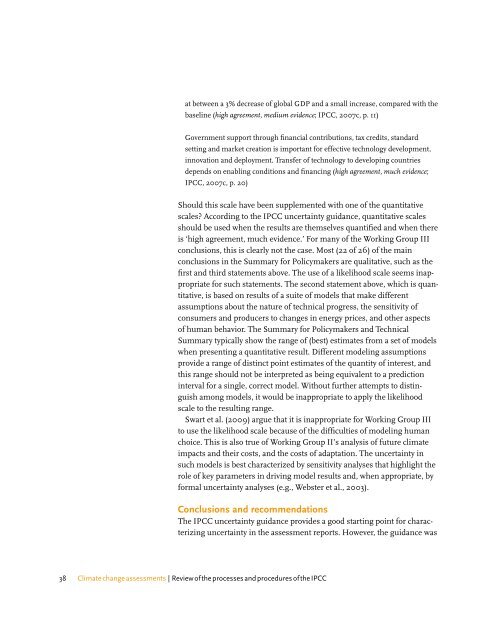Climate change assessments Review of the processes and ...
Climate change assessments Review of the processes and ...
Climate change assessments Review of the processes and ...
Create successful ePaper yourself
Turn your PDF publications into a flip-book with our unique Google optimized e-Paper software.
at between a 3% decrease <strong>of</strong> global GDP <strong>and</strong> a small increase, compared with <strong>the</strong><br />
baseline (high agreement, medium evidence; IPCC, 2007c, p. 11)<br />
Government support through financial contributions, tax credits, st<strong>and</strong>ard<br />
setting <strong>and</strong> market creation is important for effective technology development,<br />
innovation <strong>and</strong> deployment. Transfer <strong>of</strong> technology to developing countries<br />
depends on enabling conditions <strong>and</strong> financing (high agreement, much evidence;<br />
IPCC, 2007c, p. 20)<br />
Should this scale have been supplemented with one <strong>of</strong> <strong>the</strong> quantitative<br />
scales? According to <strong>the</strong> IPCC uncertainty guidance, quantitative scales<br />
should be used when <strong>the</strong> results are <strong>the</strong>mselves quantified <strong>and</strong> when <strong>the</strong>re<br />
is ‘high agreement, much evidence.’ For many <strong>of</strong> <strong>the</strong> Working Group III<br />
conclusions, this is clearly not <strong>the</strong> case. Most (22 <strong>of</strong> 26) <strong>of</strong> <strong>the</strong> main<br />
conclusions in <strong>the</strong> Summary for Policymakers are qualitative, such as <strong>the</strong><br />
first <strong>and</strong> third statements above. The use <strong>of</strong> a likelihood scale seems inappropriate<br />
for such statements. The second statement above, which is quantitative,<br />
is based on results <strong>of</strong> a suite <strong>of</strong> models that make different<br />
assumptions about <strong>the</strong> nature <strong>of</strong> technical progress, <strong>the</strong> sensitivity <strong>of</strong><br />
consumers <strong>and</strong> producers to <strong>change</strong>s in energy prices, <strong>and</strong> o<strong>the</strong>r aspects<br />
<strong>of</strong> human behavior. The Summary for Policymakers <strong>and</strong> Technical<br />
Summary typically show <strong>the</strong> range <strong>of</strong> (best) estimates from a set <strong>of</strong> models<br />
when presenting a quantitative result. Different modeling assumptions<br />
provide a range <strong>of</strong> distinct point estimates <strong>of</strong> <strong>the</strong> quantity <strong>of</strong> interest, <strong>and</strong><br />
this range should not be interpreted as being equivalent to a prediction<br />
interval for a single, correct model. Without fur<strong>the</strong>r attempts to distinguish<br />
among models, it would be inappropriate to apply <strong>the</strong> likelihood<br />
scale to <strong>the</strong> resulting range.<br />
Swart et al. (2009) argue that it is inappropriate for Working Group III<br />
to use <strong>the</strong> likelihood scale because <strong>of</strong> <strong>the</strong> difficulties <strong>of</strong> modeling human<br />
choice. This is also true <strong>of</strong> Working Group II’s analysis <strong>of</strong> future climate<br />
impacts <strong>and</strong> <strong>the</strong>ir costs, <strong>and</strong> <strong>the</strong> costs <strong>of</strong> adaptation. The uncertainty in<br />
such models is best characterized by sensitivity analyses that highlight <strong>the</strong><br />
role <strong>of</strong> key parameters in driving model results <strong>and</strong>, when appropriate, by<br />
formal uncertainty analyses (e.g., Webster et al., 2003).<br />
Conclusions <strong>and</strong> recommendations<br />
The IPCC uncertainty guidance provides a good starting point for characterizing<br />
uncertainty in <strong>the</strong> assessment reports. However, <strong>the</strong> guidance was<br />
38 <strong>Climate</strong> <strong>change</strong> <strong>assessments</strong> | <strong>Review</strong> <strong>of</strong> <strong>the</strong> <strong>processes</strong> <strong>and</strong> procedures <strong>of</strong> <strong>the</strong> IPCC

















